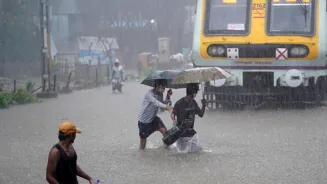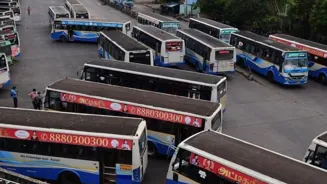Between June 1 and August 10, the country recorded 539 mm of rain against a normal of 535.6 mm, about 1% above the long-period average.
Of the 36 states and union territories for which the IMD provides figures, 25 are in the "normal" category (within 19% of the long-period average), five are "deficient" (20 to 59% below normal), five are in the "excess" category (20 to 59% above normal) and one (Ladakh) is in the "large excess" category (more than 60% above normal).
No state or union territory is in
Arunachal Pradesh, Assam, Meghalaya, Sikkim and Bihar have recorded seasonal shortfalls.
Arunachal Pradesh gauged 652.1 mm against a normal of 1,081.0 mm (about 40% below normal), Assam 603.8 mm (37% below normal), Meghalaya 978.7 mm (45% below normal), Sikkim 837.4 mm (20% below normal) and Bihar 438.3 mm (25% below).
Five states or union territories are in the excess category - Jharkhand (853.7 mm; 41% above normal), Delhi (433.5 mm; 37% above), Rajasthan
Ladakh stands out in the large-excess column with 31.8 mm against a normal of 14.8 mm (about 115% above normal).
Twenty-five states and union territories, spanning north, central, east and south India, recorded seasonal totals within ±19% of the long-period average.
This group includes Uttar Pradesh (478.0 mm; 11% above normal), Maharashtra (585.2 mm; about 9% below normal but within the normal band) and Karnataka (587.8 mm;
While the cumulative picture shows the country close to normal, the season has been marked by sharp spatial and temporal variability.
Parts of the western Himalayas, especially Himachal Pradesh and Uttarakhand, have seen cloudbursts, flash floods and widespread landslides in July and early August, disrupting roads and local life.
The national capital region also faced episodes of heavy downpour and waterlogging in late July and early August.
The IMD has noted the unevenness of
However, some pockets, including parts of the northeast and adjoining eastern India, are expected to remain on the drier side.
The IMD has also said that northeast India has experienced below-normal rainfall for several consecutive years and warned of continuing regional differences in rainfall activity.
In May, the IMD predicted that India
The monsoon plays a critical role in India's agriculture sector, which supports the livelihood of around 42% of the population and contributes 18.2% to the national GDP. It is also crucial for replenishing reservoirs used for drinking water and power generation.













